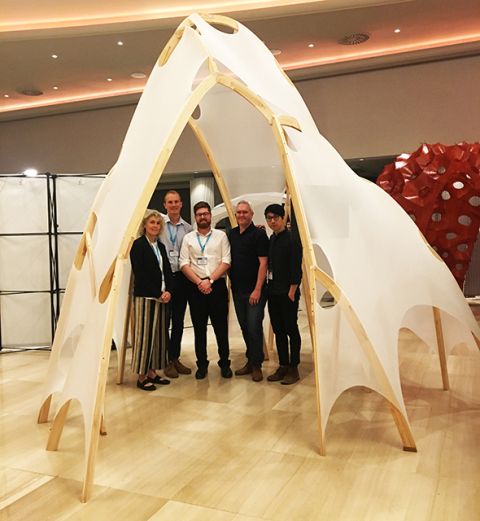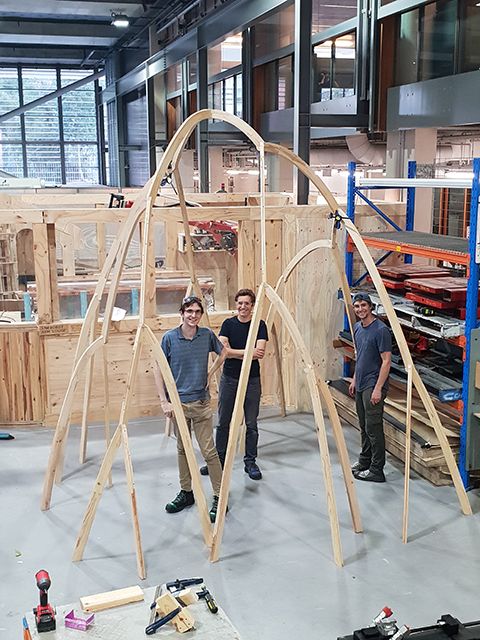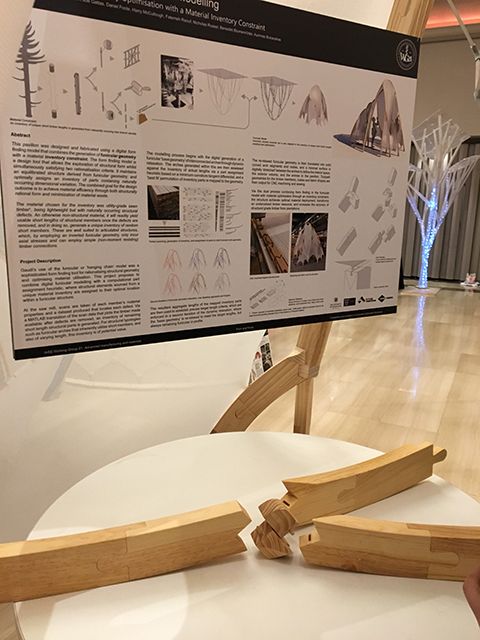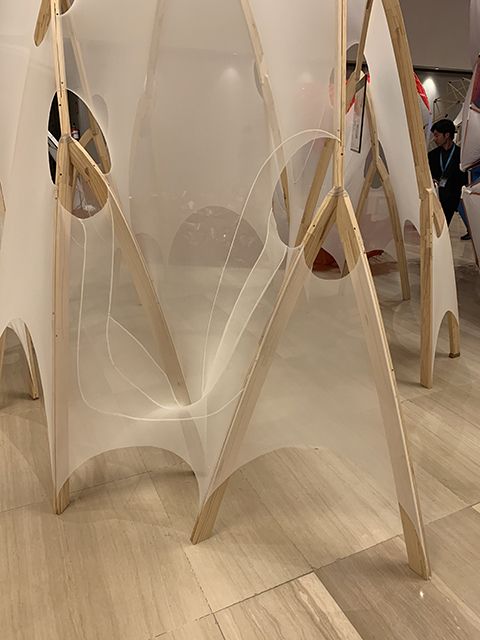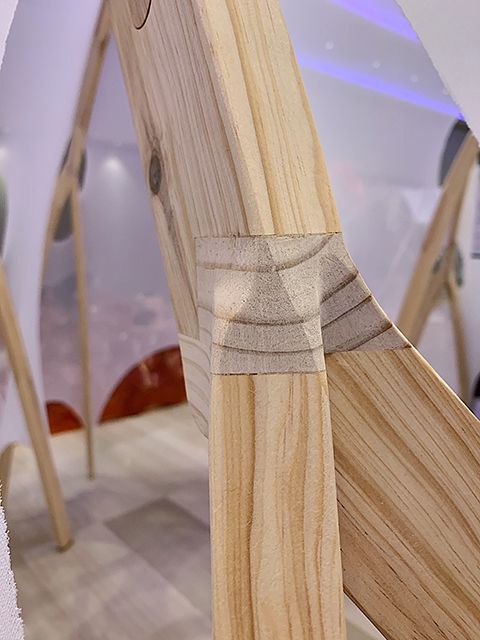The winners of Australia’s peak international design awards – the highest honour for design and innovation in the country were announced on the 9 September 2020 during the 2020 Good Design Week.
The Suspended Remnants - Timber Pavilion, which is a structure created from a collaboration between two ARC Future Timber Hub Projects, Alternative uses for under-valued sawmill products in innovative timber structures and Prefabrication and digital fabrication strategies for large-scale timber construction, received a prestigious Good Design Award Gold Accolade in the Engineering Design category in recognition for outstanding design and innovation.
The annual Good Design Awards is Australia’s oldest and most prestigious international Awards for design and innovation with a proud history dating back to 1958. The Awards celebrate the best new products and services on the Australian market, excellence in architectural design, engineering, fashion, digital and communication design, design strategy, social impact design and young designers.
More than 55 Good Design Awards Jurors evaluated each entry according to a strict set of design criteria which covers ‘good design’, ‘design innovation’ and ‘design impact’. Projects recognised with a Good Design Award must demonstrate excellence in good design and convince the Jury they are worthy of recognition at this level.
About Suspended Remnants
The Suspended remnants Pavilion was designed and fabricated using a bespoke computational tool that combines the generation of structurally efficient geometry with a material inventory constraint. Through automation, an inventory of timber members of short unique lengths, typically deemed unusable in the industry, are repurposed into high value architectural components.
Designed By:
- Kim Baber
- Jane Burry
- Canhui Chen
- Joe Gattas
- Aurimas Bukauskas
Commissioned By:
International association for shell and spatial structures
Designed In: Australia
The Good Design Awards Jury praised Suspended Remnants, commenting: “The innovation applied in material optimisation and form finding optimisation using computational tools is highly commended, as is the creativity in optimising material management from source timber. The engineered connections is unique, and have applications which are both scalable, and suited to 3D printing. ”
Dr. Brandon Gien, CEO of Good Design Australia said: “Receiving a Good Design Award is a significant achievement given the very high calibre and record number of entries received in 2020.”
“There’s no doubt it has been a really tough year for everyone so it’s nice to be able to share some good news for a change. The projects represented in this year’s Good Design Awards shine a positive light on our creative and innovative capacity as human beings. These inspirational winning projects give me hope and optimism that our design community will continue to innovate, no matter how challenging the world around us is,” said Dr. Gien.
“Australia’s Good Design Award is more than a symbol of design excellence - it represents the hard work and dedication towards an innovative outcome that will ultimately make our lives better. These projects showcase the shear brilliance of design and the potential it has to improve our world,” said Dr. Gien.
The 2020 Good Design Awards attracted a record number of submissions with an astonishing 835 design projects evaluated in this year’s international design awards.
Chief Investigator, Kim Baber explained, "These awards recognise design achievements across a wide range of disciplines. Our project has been a genuine collaboration between the fields of Architecture and Engineering, combining attention to detail in the crafting of timber and fabric elements combined with sophisticated computational design."
The ARC Future Timber Hub give a special thank you to our research collaborators, Swinburne University of Technology (special mention to Canhui Chen), who submitted the entry with The University of Queensland and special mention to the support given to the project from ARC Future Timber Hub Industry Partner, Hyne Timber.
Further Information
The pavilion is a structural outcome from two research projects in the ARC Future Timber Hub that aims to minimise waste timber through an innovative design process entitled 'inventory constrained design'. Researchers have coupled this with funicular modelling, a design process that was used by Catalan Architect Antoni Gaudí over a century ago.
"Inventory Constrained Design describes an approach to design and fabrication that seeks to result in a low ratio of waste material from a specific inventory of parts, and it is an approach that has applications at a range of different scales. The pavilion was a small scaled demonstration of the design process, we are currently working with our industry partners Hyne Timber to look at how it could be applied to larger volumes of stock," Kim Baber advised.
The two ARC Future Timber Hub Projects, Project 15 - Alternative uses for under-valued sawmill products in innovative timber structures and Project 16 - Prefabrication and digital fabrication strategies for large-scale timber construction, have been investigated in parallel, through collaborative research of the Chief Investigators Kim Baber & Joe Gattas. "A key methodology in developing Project 15’s alternative uses for under-valued sawmill products is re-thinking the design and fabrication process. Sophisticated computational design processes investigated in Project 16 such as Inventory Constrained Design, are an integral part", Kim Baber explained. "We are continuing to develop tools in Future Timber Hub Projects 15 and 16 that investigate how the design process can be applied to specific Engineered Wood Products."
The structure was created with assistance from Jane Burry and Canhui Chen from the Swinburne University of Technology who were invited to collaborate with the Future Timber Hub for the original IASS pavilion design competition in 2018. "They have been integral team members from the outset of the project, providing conceptual and technical rigour that draws on their international expertise in the fields of advanced construction and digital design. We are looking forward to working with them on other projects in the future," Kim Baber added.
The full Research Project team includes: University of Queensland researchers and Future Timber Hub Chief Investigators, Kim Baber and Joe Gattas; research partners from Swinburne University of Technology, Jane Burry and Canhui Chen; students and graduates from the UQ's School of Architecture including Daniel Foote, Harry McCullough, Fatemeh Raouf and Nick Russel, and visiting timber researchers from the University of Kaiserslautern, Benedikt Blumenröder and from the University of Bath, Aurimas Bukauskas. The pavilion was fabricated in the Future Timber Hubs’ Architecture Workshops at UQ with support of Sam Butler and Mark Lynne, and the support of the ARC Future Timber Hub Industry Partner, Hyne Timber.
The structure was exhibited last year in Barcelona and received a Commendation at The International Association for Shell and Spatial Structures Conference ‘Advanced Manufacturing and Materials’ Competition. From over 30 entrants the Future Timber Hub Pavilion was one of only four to receive this award.
It was exhibited at UQ in 2019 and was part of the Melbourne School of Design’s Future Prototyping Exhibition as part of Melbourne Design Week 2020.
For more information please see ARC Future Timber Hub Project:
Alternative uses for under-valued sawmill products in innovative timber structures
About Good Design Australia and Australia’s Good Design Awards
Good Design Australia is an international design promotion organisation responsible for managing Australia’s annual Good Design Awards and other signature design events. With a proud history that dates back to 1958, Good Design Australia remains committed to promoting the importance of design to business, industry, government and the general public and the critical role it plays in creating a better, safer and more prosperous world.
Entry - Suspended Remnants
2020 Entries Gallery



